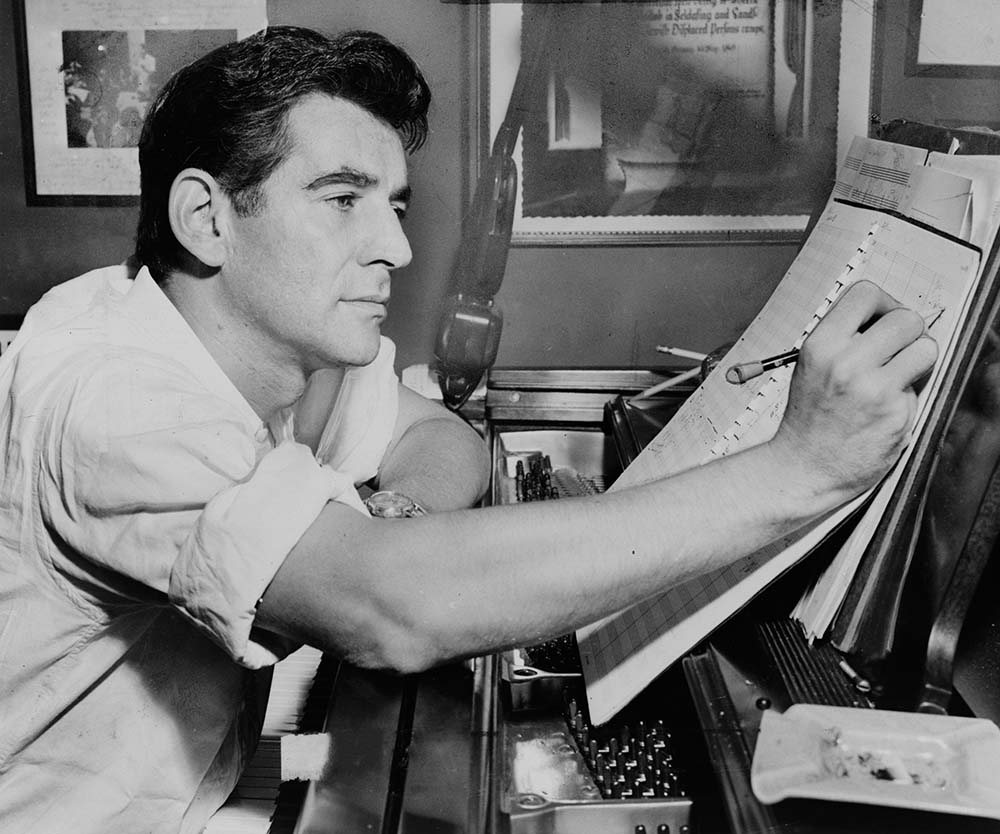[dropcap letter=”N”]
orman Lebrecht has said of Leonard Bernstein: “he was sensual and cerebral, moralist and hedonist, humble and vain, American and cosmopolitan, loving and narcissistic. He exhibited an ‘intense love of life and disgust with life’, a dichotomy he attributed to Mahler”, with whose production he recognized himself in various ways, having felt a “direct contact”. These are not just words. Bernstein’s recordings of the nine symphonies (plus the Adagio of the unfinished Tenth and the song cycles) are sensational, both the first integral with the New York Philharmonic as well as its late versions. Versions even more intense and nuanced, leading different orchestras, but with the common denominator of unequivocally passionate rigor.
“The Ninth, Mahler did not live to conduct. This one he wrote it for me”
Confirms such empathy the statement that Bernstein shared whit his closest ones: “The Ninth he did not live to conduct. This one I wrote it for me”. With a very different disposition -less high-sounding, but no less significant- he wanted to introduce the work of this visionary composer to a broad audience, specifically in the chapter “Who is Gustav Mahler?” of the series Young People’s Concert, in 1960. It may sound strange, today in day, but the fact is that at that time the Austro-Hungarian composer was not popular (as reveals, on the other hand, the limited number of LP recordings, compared to Beethoven, Mozart, Bach, and even to composers that tend to be considered less relevant).
But, going back to Lebrecht’s quote, it is worth pointing out how in a personality like Bernstein’s the contradictions were extremely fruitful, at least from the artistic perspective. A fact that, of course, also had to give rise to complicated situations; clashes of different magnitude, as we remember in the second part of this triptych, on the occasion of the recording of West Side Story. None of this is alien to the profession of conductor, because in the effort to impose a unique and coherent vision on a group of intellectually and musically trained individuals, with judgement and experience, dissent can arise, and in many cases arguably. There are endless anecdotes about the character and extravagances of the great musicians, gathered both in specialized literature and in fiction (E. T. A. Hoffmann), and also in some biographical visions more or less tendentious (for example, in the Memories of Gustav Mahler, by Alma Mahler). But, thinking about one of those that concern Bernstein, the mention of the confrontation with Glenn Gould seems obligatory.
GLENN GOULD, L’ENFANT TERRIBLE
The Canadian prodigy, himself famously eccentric even if his friend Bruno Monsaingeon has recently parodied that qualification (in his excellent book No, I am not at all an eccentric), participated with Bernstein in 1957 in a recording for Columbia, pioneer recording label, responsible for his revolutionary Goldberg Variations, in 1955, and in the field of jazz for the appearance of sound monuments such as Miles Davis’ Kind of Blue or Ah um, by Charles Mingus. Knowingly, therefore, Bernstein would welcome Gould three years later in the framework of one of his television programs, in which he offered the interpretation of a movement of the same concert recorded on that LP, the Concert in D minor, BWV 1052, by Johan Sebastian Bach.
Before the performance, thanks to his anthological communicative skills, Bernstein introduces the piece: he explains that Bach did not leave dynamic indications for the interpretation – something usual, at the time-, which demands today a creative but rigorous intervention, not without judgement, on the part of the pianist. Bernstein, on the occasion, assumes that what is included in the score could not be played just like that (“that’s unutterable dull “) and illustrates it by comparing it to a work like Hamlet. A theatre piece without indications by Shakespeare, other than the mention of the site -Elsinore, in Denmark- and the interventions of the characters; but not how to declaim or stage the situations, neither the dresses nor the physical conditions of the protagonists, etc.; that is, nothing of what is related to the actual performance, properly speaking. The idea, then, is to elaborate it coherently -even if it can never be determined positively, in a rigid and definitive way- after a complete and careful reading of the text, through the study of the circumstances of the author and the culture of the time.
The art of performing requires analytical capacity but also a dose of creativity, since it involves the recreation of a reality that, in a way, has never taken place (at least not for us, as readers or interpreters of another space-time). “That’s exactly our situation with Bach. (…) We must study the whole work, get to know its insights, and then draw our conclusions. So, Glenn Gould must decide and I as his accompanist must decide with him all the kinds of matters of tempo and phrasing and everything else that we feel necessary to convey Bach’s deepest musical meaning to you, the listener”. Bernstein goes on, in order to show, by conducting the orchestra, two different interpretative modes that he considers extreme, one romantic and majestic, the other vivid, more varied. He affirms that the optimal result is probably to be found “in between” the two of them, one with well-marked inflections and the other -the first- that qualifies as substantial. Clearly, however, he positioned in relation to the idiosyncrasy of the soloist: “In any case, what it will not be, is a dull, literal playing of the notes, if I know Mr. Gould”
 The result of that agreement is reflected in the video, each listener may judge, to the extent that the sound quality -not the best- allows it. We will agree, surely, that the version edited years ago by Columbia is more consistent. Of course, the politer Bernstein, the one who seduces through the screen, seems to have agreed with the soloist -without too much belligerence, a priori- a common area for the interpretive question. However, the agreement between soloist and conductor -here, again, Gould and Bernstein- is not always reached, as shown in a speech that Bernstein gave prior to the interpretation of the Concerto in D minor by Johannes Brahms, on April 6th, 1962, when he specifies how heterodox is his piano reading in terms of tempi and dynamics, that is, in regard to rhythmic aspects and the intonation of pulsations. “And this raises the interesting question: “What am I doing conducting it?” I’m conducting it because Mr. Gould is so valid and serious an artist that I must take seriously anything he conceives in good faith and his conception is interesting enough so that I feel you should hear it, too”. The issue does not end here, and indeed for the complete intervention even an entry has been created in the most consulted online dictionary.
The result of that agreement is reflected in the video, each listener may judge, to the extent that the sound quality -not the best- allows it. We will agree, surely, that the version edited years ago by Columbia is more consistent. Of course, the politer Bernstein, the one who seduces through the screen, seems to have agreed with the soloist -without too much belligerence, a priori- a common area for the interpretive question. However, the agreement between soloist and conductor -here, again, Gould and Bernstein- is not always reached, as shown in a speech that Bernstein gave prior to the interpretation of the Concerto in D minor by Johannes Brahms, on April 6th, 1962, when he specifies how heterodox is his piano reading in terms of tempi and dynamics, that is, in regard to rhythmic aspects and the intonation of pulsations. “And this raises the interesting question: “What am I doing conducting it?” I’m conducting it because Mr. Gould is so valid and serious an artist that I must take seriously anything he conceives in good faith and his conception is interesting enough so that I feel you should hear it, too”. The issue does not end here, and indeed for the complete intervention even an entry has been created in the most consulted online dictionary.
“I have only once before in my life had to submit to a soloist’s wholly new and incompatible concept, and that was the last time I accompanied Mr. Gould”.
The intervention, finally, incorporates a joke that awoke a burst of laughter in the audience: “I have only once before in my life had to submit to a soloist’s wholly new and incompatible concept, and that was the last time I accompanied Mr. Gould”. Instead of making a fuss, Bernstein agrees to acomplish his duty in the best way, adducing the spirit of adventure -that “sportive element” inherent to the interpretation, as Dimitri Mitropoulos told him- as well as the quality and interpretative depth of Glenn Gould: “we can all learn something from this extraordinary artist, who is a thinking performer”. The question with which we have to close this triptych dedicated to the artistic personality of Bernstein lies precisely in that element of search, which requires effort even in the best composers of the past turned into classics, which he unambiguously calls “geniuses”.
CODA WITH BEETHOVEN: THE “PRINCIPLE OF INEVITABILITY”
Let’s go back to the beginning of our triptych, in order to close; that is, back to the reflections of The Joy of Music in which Bernstein recognized to be paradoxically forced to talk and explain the kind of magic that words, concepts cannot communicate at all: pleasure is experienced in the course of musical performance thanks to a mathematical alchemy, in which rationality intervenes necessarily, being at the time unable to explain the spiritual, irrational or spiritual springs that it promotes. Hence the need to find metaphors or images -even if “doomed” to fail, he acknowledged- in order to explain the affection and the awakening of emotions that music generates. Bernstein devoted a televised talk to a capital work such as Beethoven’s Fifth, and once again his eloquence is highlighted when he focuses on the famous starting point, which we can all hum. ““People have wondered for years what it is that endows this musical figure with such potency, all kinds of fanciful music-appreciation theories have been advanced: that it is based on the song of a bird that Beethoven heard in the Vienna woods; that it is Fate knocking at the door; that it’s the trumpets announcing the Judgment Day”. The diversity of appreciations of such music, so potentially significant, is reflected in his wildest extreme in Stanley Kubrick’s A Clockwork Orange, in which the protagonist manifests his devotion to Beethoven. It is not, obviously, the only cinematographic work where his music collaborates with fiction.
None of that is universally valid, no plot or sub-text can specify the meaning of the composition, and more specifically its famous theme, at the starting point. Much more prosaic, and at the same time complex, is the answer offered by Bernstein: “The truth is that the real meaning lies in all the notes that follow it”, insofar as they are not, at all, self-evident. The effort of the composer is titanic, even in the case of a Beethoven, antithetic to the romantic myth (or, rather, Mozartian) that suggests that melodies emerge spontaneously from the mind of the creator, as if they had always been there, in a state of celestial pre-existence. Bernstein recalls that Beethoven rejected dozens of pages of sketches, only of that first movement; some of its alternatives are commented along their performance on the piano, by himself, or conducting an orchestra (in an LP that was commercialized in the sixties and seventies). After all -he explains- one does not only need to find “right notes, but the right rhythms, the right climaxes, the right harmonies, the right instrumentation”.
“The composer leaves us at the finish with the feeling that something is right in the world (…), something that follows its own laws consistently, something that we can trust, that will never let us down”
The question about the meaning of music has been transformed throughout. For what is strange and marvellous is not only the discovery of the right motif, but the tremendous endurance with which the artist seeks the best possible development and, discarding a host of possibilities, establishes it as if it were natural, until reaching what Bernstein calls the “Principle of inevitability”. The key that unravels the mystery of the great artist lies in the following: “for reasons unknown to him or to anyone else, he will give away his energies and his life just to make sure that one note follows another inevitably. It seems rather an odd way to spend one’s life; but it isn’t so odd when we think that the composer, by doing this, leaves us at the finish with the feeling that something is right in the world, that something checks throughout, something that follows its own laws consistently, something that we can trust, that will never let us down”.



















